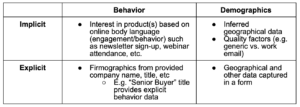Unprecedented times. The new normal. We all have our own least favorite catch phrases to describe what it’s like to live through a pandemic, just as we all have our own stories about how COVID-19 has impacted our day-to-day and professional lives. Eleven months into the year, I don’t think it’s necessary to spell out how work life has shifted, in-person engagements have dropped to all-time lows, and how so many people found new work spaces sitting somewhere in front of a Peloton.
What hasn’t changed in the midst of this pandemic and our global shift to working from home is what it takes for sales people to succeed — the ability to adapt. Adapting to fewer (if any) in-person visits, to meeting your customers where they are, to a world of yet-unknowns that will continue to crop up over time. And for those who learn to do this well, there’s a huge opportunity to not just succeed but excel.
Throughout my tech career I’ve worked with dozens of sales representatives. Over the past year, I’ve watched top performers struggle to close a single deal all month. I’ve seen sales people with traditionally challenging territories knock it out of the park. I’ve also had a lot of conversations with my sales reps. Here’s what I’m hearing:
What is the rest of the team doing to succeed? Why is it working for them but not me? Why is it that what used to work for me no longer works?
There’s no one-size-fits-all answer. That’s why adaptability is key. But it leaves an uncomfortable gray area when it comes to how we should change. What it comes down to is this:
How are you adapting to your customers’ needs? How are you adapting your sales process to our new digital-first world? Are you willing to make the changes necessary to succeed?
As you ponder these questions, here are three ways that technology and insights can help you reach the right answers for you and your team.
1. Collaboration
The best sales reps are not lone wolves. For some, this isn’t a surprise. For others, it may be difficult to let go of being in control, trust others to get the job done, or admit that they aren’t always (and don’t have to be) the smartest person in the room.
There’s value in having multiple roles supporting the sales process. Realizing that you don’t have to go it alone can help you close bigger deals faster and smarter.
- Understand the roles and functions that surround sales at your company. With this basic level of knowledge, you can’t collaborate effectively.
- Take stock of where you get the most value. This may not be linear — think about what you need depending on the situation you’re in, or the stage of the sales process.
- Provide feedback on what’s working well or what could work better. And be open to receiving and acting on feedback as well.
2. Insights & Intelligence
Once you’ve identified your key internal stakeholders and what they bring to the table, it’s important to put that information to work. One of my favorite synergies is when marketing and sales are truly aligned and build a holistic view of the customer journey together. By understanding where your customer has been and where they are now, you can help them get to where they’re going more effectively.
- Familiarize yourself with your prospects’ activities before they land in your lead queue. When you understand the content that prospects are engaging with on your website and through their inboxes, you can start identifying their interests before you ever talk to them.
- Find your account champion. When you’re selling to a company, the purchasing decision typically sits with more than one person. Finding the right contact to facilitate introductions and help sell your product or services internally can make all the difference. If you have visibility into who’s engaging with your content, how much they’re engaging, and how they’re engaging, this knowledge can help you pinpoint how to start the conversation.
- Invest in artificial intelligence (AI) to remove human bias from the equation and glean insights you may not have known to look for. AI can help uncover a subsegment of prospects that responds more positively to certain messages or identify leads that are most likely to convert into contacts. Using unbiased insights helps focus your efforts where they’ll have the most impact.
3. Organization
 Juggling all of your accounts at different stages and with different business needs is hard enough. But when this information is stored in your mind or simply written down, it’s difficult to find, access, and share. Putting effort into the following can go a long way:
Juggling all of your accounts at different stages and with different business needs is hard enough. But when this information is stored in your mind or simply written down, it’s difficult to find, access, and share. Putting effort into the following can go a long way:
- Use the tools at your disposal. Having a CRM doesn’t help you if you’re not actually using it. When you add and update key information, it helps everyone you’re collaborating with to stay on the same page, and empowers you to draw comparisons across accounts. When processes like lead funnel stages and opportunity statuses are standardized, you can easily look across all of your accounts and prospects to see where the needle is moving and where you’ve hit a roadblock.
- Make the most of repeatable processes. Each account may need something slightly different, but that doesn’t mean you can’t learn from what’s worked in the past and make the necessary tweaks to get it to resonate. Once you know which campaigns helped to push opportunities across the finish line, you can use that knowledge to your advantage. For example, you can maintain a library of email templates that get the best responses. Learn, organize, and optimize.
- Prioritize your time and effort. There are only so many hours in the day. If you’re ready to start your day with a call blitz, how will you ensure that you’re calling on the hottest prospects first? Using tools like lead scoring and organizing your CRM leads by top lead score first ensures that you’re reaching out in an order that makes sense for your business and is most likely to lead to success.
I’ll ask again: How are you adapting to your customers’ needs? How are you adapting your sales process to our digital-first world? Are you willing to make the changes necessary to succeed?
Change is inevitable. So think about that last question. I’ve just laid out the key trends I’ve observed in my most resilient sales reps. It’s time for a bit of self-reflection to understand if you’re ready, willing, and able to adapt.
Register for our Dec. 16 Pardot-Like-a-Pro webinar to learn how to sell smarter with Pardot in 2021.



